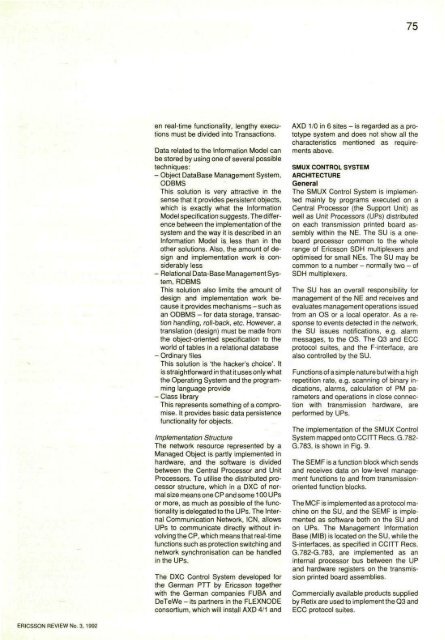An Introduction to the Ericsson Transport Network Architecture ...
An Introduction to the Ericsson Transport Network Architecture ...
An Introduction to the Ericsson Transport Network Architecture ...
You also want an ePaper? Increase the reach of your titles
YUMPU automatically turns print PDFs into web optimized ePapers that Google loves.
75<br />
en real-time functionality, lengthy executions<br />
must be divided in<strong>to</strong> Transactions.<br />
Data related <strong>to</strong> <strong>the</strong> Information Model can<br />
be s<strong>to</strong>red by using one of several possible<br />
techniques:<br />
- Object DataBase Management System,<br />
ODBMS<br />
This solution is very attractive in <strong>the</strong><br />
sense that it provides persistent objects,<br />
which is exactly what <strong>the</strong> Information<br />
Model specification suggests. The difference<br />
between <strong>the</strong> implementation of <strong>the</strong><br />
system and <strong>the</strong> way it is described in an<br />
Information Model is less than in <strong>the</strong><br />
o<strong>the</strong>r solutions. Also, <strong>the</strong> amount of design<br />
and implementation work is considerably<br />
less<br />
- Relational Data-Base Management System,<br />
RDBMS<br />
This solution also limits <strong>the</strong> amount of<br />
design and implementation work because<br />
it provides mechanisms - such as<br />
an ODBMS - for data s<strong>to</strong>rage, transaction<br />
handling, roll-back, etc. However, a<br />
translation (design) must be made from<br />
<strong>the</strong> object-oriented specification <strong>to</strong> <strong>the</strong><br />
world of tables in a relational database<br />
- Ordinary files<br />
This solution is '<strong>the</strong> hacker's choice'. It<br />
is straightforward in that it uses only what<br />
<strong>the</strong> Operating System and <strong>the</strong> programming<br />
language provide<br />
- Class library<br />
This represents something of a compromise.<br />
It provides basic data persistence<br />
functionality for objects.<br />
Implementation Structure<br />
The network resource represented by a<br />
Managed Object is partly implemented in<br />
hardware, and <strong>the</strong> software is divided<br />
between <strong>the</strong> Central Processor and Unit<br />
Processors. To utilise <strong>the</strong> distributed processor<br />
structure, which in a DXC of normal<br />
size means one CP and some 100 UPs<br />
or more, as much as possible of <strong>the</strong> functionality<br />
is delegated <strong>to</strong> <strong>the</strong> UPs. The Internal<br />
Communication <strong>Network</strong>, ICN, allows<br />
UPs <strong>to</strong> communicate directly without involving<br />
<strong>the</strong> CP, which means that real-time<br />
functions such as protection switching and<br />
network synchronisation can be handled<br />
in <strong>the</strong> UPs.<br />
The DXC Control System developed for<br />
<strong>the</strong> German PTT by <strong>Ericsson</strong> <strong>to</strong>ge<strong>the</strong>r<br />
with <strong>the</strong> German companies FUBA and<br />
DeTeWe - its partners in <strong>the</strong> FLEXNODE<br />
consortium, which will install AXD 4/1 and<br />
AXD 1/0 in 6 sites - is regarded as a pro<strong>to</strong>type<br />
system and does not show all <strong>the</strong><br />
characteristics mentioned as requirements<br />
above.<br />
SMUX CONTROL SYSTEM<br />
ARCHITECTURE<br />
General<br />
The SMUX Control System is implemented<br />
mainly by programs executed on a<br />
Central Processor (<strong>the</strong> Support Unit) as<br />
well as Unit Processors (UPs) distributed<br />
on each transmission printed board assembly<br />
within <strong>the</strong> NE. The SU is a oneboard<br />
processor common <strong>to</strong> <strong>the</strong> whole<br />
range of <strong>Ericsson</strong> SDH multiplexers and<br />
optimised for small NEs. The SU may be<br />
common <strong>to</strong> a number - normally two - of<br />
SDH multiplexers.<br />
The SU has an overall responsibility for<br />
management of <strong>the</strong> NE and receives and<br />
evaluates management operations issued<br />
from an OS or a local opera<strong>to</strong>r. As a response<br />
<strong>to</strong> events detected in <strong>the</strong> network,<br />
<strong>the</strong> SU issues notifications, e.g. alarm<br />
messages, <strong>to</strong> <strong>the</strong> OS. The Q3 and ECC<br />
pro<strong>to</strong>col suites, and <strong>the</strong> F-interface, are<br />
also controlled by <strong>the</strong> SU.<br />
Functions of a simple nature but with a high<br />
repetition rate, e.g. scanning of binary indications,<br />
alarms, calculation of PM parameters<br />
and operations in close connection<br />
with transmission hardware, are<br />
performed by UPs.<br />
The implementation of <strong>the</strong> SMUX Control<br />
System mapped on<strong>to</strong> CCITT Recs. G.782-<br />
G.783, is shown in Fig. 9.<br />
The SEMF is a function block which sends<br />
and receives data on low-level management<br />
functions <strong>to</strong> and from transmissionoriented<br />
function blocks.<br />
The MCF is implemented as a pro<strong>to</strong>col machine<br />
on <strong>the</strong> SU, and <strong>the</strong> SEMF is implemented<br />
as software both on <strong>the</strong> SU and<br />
on UPs. The Management Information<br />
Base (MIB) is located on <strong>the</strong> SU, while <strong>the</strong><br />
S-interfaces, as specified in CCITT Recs.<br />
G.782-G.783, are implemented as an<br />
internal processor bus between <strong>the</strong> UP<br />
and hardware registers on <strong>the</strong> transmission<br />
printed board assemblies.<br />
Commercially available products supplied<br />
by Retix are used <strong>to</strong> implement <strong>the</strong> Q3 and<br />
ECC pro<strong>to</strong>col suites.
















